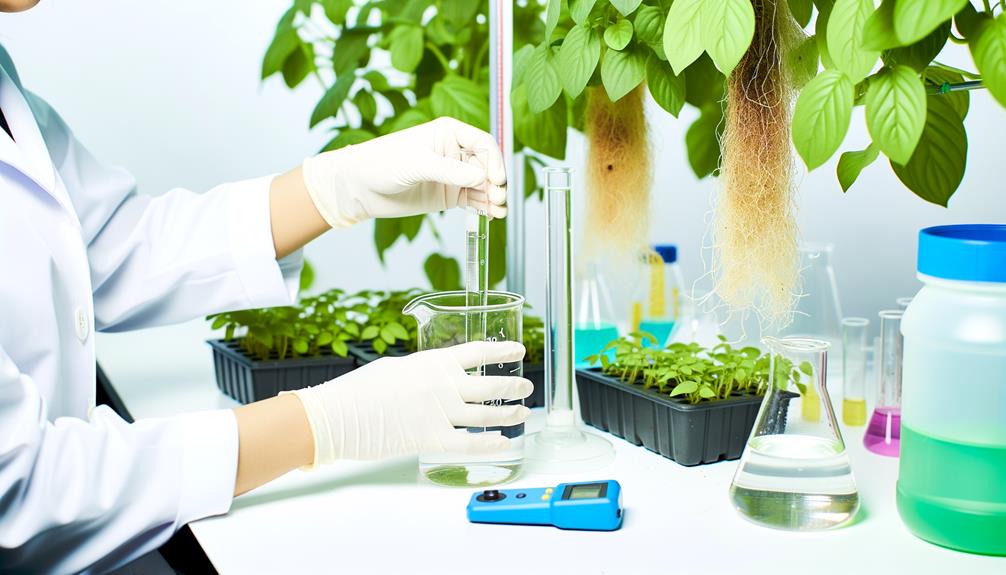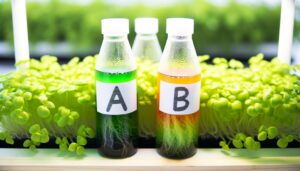Recipe for Hydroponic Nutrient Solution
Creating a precise hydroponic nutrient solution involves combining macronutrients such as calcium nitrate, monoammonium phosphate, and potassium sulfate, with secondary macronutrients like calcium chloride, magnesium sulfate, and sulfur. Essential micronutrients including chelated forms of iron, manganese, zinc, and other trace elements are added to enhance plant growth.
Begin with distilled water, dissolve macronutrients first, introduce chelated micronutrients next, and guarantee continuous stirring for homogeneity. Maintain a pH range of 5.5 to 6.5 for ideal nutrient absorption.
Proper storage in airtight, UV-resistant containers and regular pH monitoring are imperative. Further specifics will guide you through perfecting your nutrient solutions.

Key Takeaways
- Begin with distilled water and dissolve macronutrients (N, P, K) sequentially.
- Add chelated micronutrients (Fe, Mn, Zn) after the macronutrients for better solubility.
- Maintain a pH range of 5.5 to 6.5 for optimal nutrient uptake.
- Use high-purity, water-soluble compounds to ensure effective nutrient delivery.
Essential Nutrients

Essential nutrients for hydroponic systems encompass a range of macro and micronutrients that are essential for ideal plant growth and development.
Key macronutrients include nitrogen (N), phosphorus (P), and potassium (K), often referred to as N-P-K. These elements are fundamental for processes such as photosynthesis, energy transfer, and protein synthesis.
Additionally, secondary macronutrients like calcium (Ca), magnesium (Mg), and sulfur (S) play important roles in structural integrity and enzyme function.
Micronutrients, required in smaller quantities, include iron (Fe), manganese (Mn), zinc (Zn), copper (Cu), boron (B), molybdenum (Mo), and chlorine (Cl).
Each micronutrient participates in specific physiological functions, such as chlorophyll synthesis and hormone regulation, ensuring thorough plant health and robust growth in hydroponic environments.
Choosing the Right Ingredients
Selecting the appropriate ingredients for a hydroponic nutrient solution is critical to guarantee the ideal balance of macro and micronutrients necessary for plant health and growth. A well-formulated hydroponic nutrient solution should contain essential macronutrients like nitrogen, phosphorus, and potassium, along with vital micronutrients such as iron, manganese, and zinc. When preparing a hydroponic nutrient solution for basil, it’s important to maintain the right pH and electrical conductivity (EC) levels to optimize nutrient uptake. Proper nutrient management ensures vigorous growth, enhances flavor, and maximizes yield in hydroponic basil cultivation.
The primary macronutrients include nitrogen (N), phosphorus (P), and potassium (K), often sourced from compounds like calcium nitrate, monoammonium phosphate, and potassium sulfate.
Secondary macronutrients, such as calcium (Ca), magnesium (Mg), and sulfur (S), are supplied through calcium chloride, magnesium sulfate, and potassium sulfate.
Micronutrients, though required in smaller amounts, are equally crucial and include iron (Fe), manganese (Mn), zinc (Zn), copper (Cu), molybdenum (Mo), and boron (B).
Chelated forms of these micronutrients, such as Fe-EDTA for iron, provide stability and bioavailability.
Selecting high-purity, water-soluble compounds is necessary for peak nutrient uptake.
Mixing Your Solution

To achieve an ideal hydroponic nutrient solution, meticulously measure and dissolve each ingredient in a specific order to guarantee proper nutrient availability and prevent precipitation.
Begin by filling your mixing container with distilled water.
Dissolve macronutrients such as nitrogen, phosphorus, and potassium, confirming complete dissolution before adding the next.
Follow with micronutrients, including iron, manganese, and zinc, in their chelated forms to enhance solubility.
Stir continuously to maintain homogeneity.
Avoid combining calcium and sulfate directly; introduce calcium nitrate separately to prevent gypsum formation.
Finally, incorporate any pH buffers or stabilizers as needed.
Thorough mixing and strict adherence to sequence confirm a balanced nutrient profile, critical for ideal plant growth in a hydroponic system.
Monitoring Ph Levels
Maintaining ideal pH levels is critical for nutrient uptake efficiency and overall plant health in a hydroponic system. The best pH range for most hydroponic plants is between 5.5 and 6.5. Regular monitoring and adjustment are necessary to avoid nutrient lockout, which can occur if the pH deviates from this range. A digital pH meter is recommended for precise readings. Below is a table outlining the pH levels for various hydroponic plants:
| Plant Type | Best pH Range |
|---|---|
| Leafy Greens | 5.5 – 6.0 |
| Fruiting Plants | 5.8 – 6.2 |
| Herbs | 6.0 – 6.5 |
| Root Vegetables | 6.0 – 6.5 |
| Flowers | 5.8 – 6.2 |
Regular calibration of your pH meter guarantees accuracy, thereby maintaining plant health.
Storing and Using the Solution

Proper storage of your hydroponic nutrient solution is essential to maintain its efficacy and prevent contamination.
Store the solution in a cool, dark place, ideally between 10-20°C (50-68°F), to minimize nutrient degradation and microbial growth.
Use opaque, UV-resistant containers to shield the solution from light exposure, which can cause nutrient breakdown.
Make certain lids are tightly sealed to prevent air and contaminants from entering.
Regular agitation of the stored solution helps maintain homogeneity, preventing nutrient settling.
When using the solution, measure precise amounts to avoid over-fertilization or nutrient imbalances.
Always check pH and electrical conductivity (EC) before application, adjusting as necessary to guarantee ideal nutrient availability for your hydroponic system.
Conclusion
The formulation of an effective hydroponic nutrient solution necessitates an extensive understanding of essential nutrients, the selection of appropriate ingredients, meticulous mixing, vigilant pH monitoring, and proper storage techniques.
For instance, in a controlled study, tomato plants nourished with a precisely balanced hydroponic solution exhibited a 20% increase in yield compared to those grown in traditional soil.
Such empirical evidence underscores the critical importance of adhering to scientifically validated protocols to optimize plant health and productivity in hydroponic systems.






